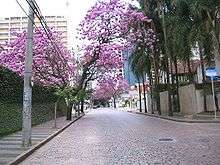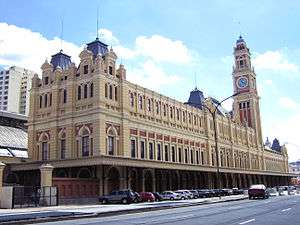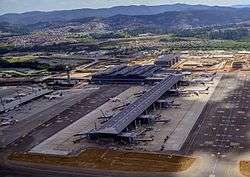Southeast Region, Brazil
| Southeast Region Região Sudeste | |
|---|---|
| Region | |
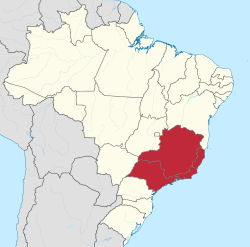 Location of Southeast Region in Brazil | |
| Coordinates: 23°33′S 46°38′W / 23.550°S 46.633°WCoordinates: 23°33′S 46°38′W / 23.550°S 46.633°W | |
| Country |
|
| States | ES, MG, RJ and SP |
| Area | |
| • Region | 924,511.3 km2 (356,955.8 sq mi) |
| Area rank | 4th |
| Population (2010 census) | |
| • Region | 80,353,724 |
| • Rank | 1st |
| • Density | 87/km2 (230/sq mi) |
| • Density rank | 1st |
| • Urban | 92% |
| GDP | |
| • Year | 2008/2008 estimate |
| • Total | R$1.698.590.000.000,00 (1st) |
| • Per capita | R$21.182,68 (1st) |
| HDI | |
| • Year | 2000–2006 |
| • Category | 0.824 – high (2nd) |
| • Life expectancy | 73.5 years (2nd) |
| • Infant mortality | 18.3 per 1,000 (4th) |
| • Literacy | 94% (2nd) |
| Time zone | BRT (UTC-03) |
| • Summer (DST) | BRST (UTC-02) |
The Southeast Region of Brazil (Portuguese: Região Sudeste do Brasil) is composed by the states of Espírito Santo, Minas Gerais, Rio de Janeiro and São Paulo. It is the richest region of the country, responsible for approximately 60% of the Brazilian GDP. São Paulo, Rio de Janeiro and Minas Gerais are three richest states of Brazil, the top three Brazilian states in terms of GDP. The Southeast of Brazil also has the highest GDP per capita among all Brazilian regions.
The Southeast region leads the country in population, urban population, population density, vehicles, industries, universities, airports, ports, highways, hospitals, schools, houses and many other areas.
São Paulo-Guarulhos International Airport, Galeão - Antônio Carlos Jobim International Airport, Confins International Airport and Vitoria Airport connects Southeast region with many Brazilian cities and also operates some international flights.
The Southeast is home to the University of São Paulo, Federal University of Minas Gerais, Federal University of Rio de Janeiro, Federal University of Espírito Santo, Federal Rural University of Rio de Janeiro, Campinas State University, Federal University of Ouro Preto, Fluminense Federal University, Federal University of São Paulo, Federal University of Viçosa, State University of Campinas, Federal University of Uberlandia, Federal University of Sao Carlos, Federal University of Juiz de Fora, State University of Minas Gerais, Pontifical Catholic University of Minas Gerais, Pontifical Catholic University of Rio de Janeiro, Pontifical Catholic University of São Paulo and Rio de Janeiro State University.
Geography
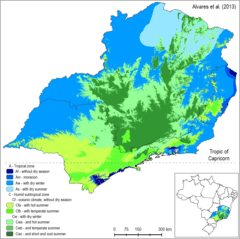
Heart of the largest continued remnant of the Brazilian Atlantic Forest, the Ribeira Valley is a Natural Heritage of Humanity, granted heritage as a Biosphere Reserve by UNESCO. One of the biggest attractions is the biologic and ecosystems diversity, where approximately 400 species of birds, amphibians, reptiles and mammals live. The Alto Ribeira State and Tourist Park (PETAR) is paradise for ecotourists, for its enormous diversity in geologic formations, among grottos and caves, rivers and waterfalls. There are currently 454 caves registered by the Brazilian Society of Speleology (SBE) in the State of São Paulo, all at the Ribeira Valley. The 280 caves located at PETAR represent the biggest concentration of caves in Brazil.


The landscape of the State is marked by mountains, valleys and caverns. In the Serra do Cipó, Sete Lagoas, Cordisburgo and Lagoa Santa, the caves and waterfalls. Minas Gerais is the source of some of the biggest rivers in Brazil, most notably the São Francisco, the Paraná and to a lesser extent, the Rio Doce. The state also holds many hydroelectric power plants, including Furnas. Some of the highest peaks in Brazil are in the mountain ranges in the southern part of the state, such as Serra da Mantiqueira and Serra do Cervo, that mark the border between Minas and its neighbors São Paulo and Rio de Janeiro. The most notable one is the Pico da Bandeira, the third highest mountain in Brazil at 2890 m, standing on the border with Espírito Santo state. The state also has huge reserves of iron and sizeable reserves of gold and gemstones, including emerald, topaz and aquamarine mines.
The state is part of the Mata Atlântica biome, and its topography comprises both mountains and plains, located between the Mantiqueira Mountains and the Atlantic Ocean. Its coast is carved by the bays of Guanabara, Sepetiba and Ilha Grande. There are prominent slopes near the ocean, featuring also diverse environments, such as restinga vegetation, bays, lagoons and tropical forests. Rio de Janeiro is the smallest state in the Southeast macroregion and one of the smallest in Brazil. It has, however, the third longest coastline in the country (second only to Bahia's and Maranhão's), extending 635 kilometers.
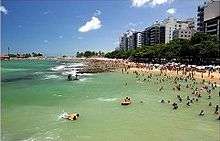
With 46.180 square kilometers, it is about the size of Estonia, or half the size of Portugal, and has a variety of habitats including coastal plains, lakes, mountain forest, mangroves and many others. The main river in the state is the Doce. Other important river basins include the Santa Maria River Basin which is the northern branch of rivers which join the sea at Vitoria, and Jucu River Basin which flows into the sea at roughly the same place, but corresponds to the southern branch (which seems to come out of Vitoria). Espírito Santo's climate is tropical along the coast, with dry winters and rainy summers. North of Doce River it's generally drier and also hot. In the mountainous regions in the south and south west of the state, the tropical climate is strongly influenced by altitude, and the average temperatures are colder. The state can be divided into two areas: the low lying coastline and the highland area known as Serra (where one can find the 2.890 m Pico da Bandeira mountain), which is part of the larger Serra do Caparaó, the Caparaó Mountain Range. In the map to the right it is in the gray area in the extreme southwest of the state, and is shared with Minas Gerais.
Demographics
Largest cities
| City | Population (IBGE/2010)[2] |
|---|---|
| | 11,253,503 |
| | 6,320,446 |
| | 2,375,151 |
| | 1,221,979 |
| | 1,080,113 |
| | 999,728 |
| | 855,048 |
| | 796,257 |
| | 765,463 |
| | 676,407 |
Racial groups
| Skin color/Race (IBGE/2010)[3] | % |
|---|---|
| White | 55.16% |
| Multiracial (Lightskin) | 35.69% |
| Afro-Brazilian | 7.91% |
| Asian | 1.11% |
| Amerindian | 0.12% |
| Not declared | 0.01% |
Economy
São Paulo state is responsible for approximately one-third of Brazilian GDP. The state's GDP (PPP) consists of 550 billion dollars, making it also the second biggest economy of South America after Brazil and the biggest subdivision economy in Latin America. Its economy is based on machinery, the automobile and aviation industries, services, financial companies, commerce, textiles, orange growing, sugar cane and coffee production. Minas Gerais is a growing state.
Infrastructure
Vehicles: 36,030,943 (Jan/2012);[4] Telephones: 23,878,000 (April/2007); Cities: 1,668 (2007).
Education
Portuguese is the official national language, and thus the primary language taught in schools. English and Spanish are also part of the official high school curriculum. French is also widely studied.
Educational institutions
- Universidade de São Paulo (USP);
- Universidade Federal do Rio de Janeiro (UFRJ);
- Universidade Federal de Minas Gerais (UFMG);
- Universidade Federal do Espírito Santo (Ufes);
- Universidade Estadual de Campinas (Unicamp);
- Universidade Federal Fluminense (UFF);
- Universidade Estadual Paulista (Unesp);
- Universidade Federal de Viçosa (UFV);
- Universidade Federal de São Paulo (Unifesp);
- Universidade Federal de Ouro Preto (Ufop);
- Universidade Federal de Juiz de Fora (UFJF);
- Universidade Federal de Uberlândia (Ufu);
- Universidade do Estado do Rio de Janeiro (UERJ);
- Universidade Federal de São Carlos (UFSCar);
- Universidade Federal de Lavras (UFLA);
- and many others.
Infrastructure
International Airports
São Paulo-Guarulhos International Airport connects Brazil to 28 countries and is visited every day by nearly 100 thousand people. With capacity to serve 15 million passengers a year, in two terminals, the airport currently handles 12 million users. Construction of a third passenger terminal is pending, to raise yearly capacity to 29 million passengers. The project, in the tendering phase, is part of the airport's master plan and will get under way shortly. São Paulo International Airport is also one of the main air cargo hubs in Brazil. The roughly 100 flights a day carry everything from fruits grown in the São Francisco Valley to the most sophisticated medications created by science. The airport's cargo terminal is South America's largest and stands behind only Mexico City's in all of Latin America. In 2003, over 75 thousand metric tons of freight passed through the terminal.
Since August 2004, with the transfer of many flights from Santos-Dumont Airport, Rio de Janeiro International Airport has returned to being the main doorway to Brazil. According to data from the official Brazilian travel bureau, Embratur, nearly 40% of foreign tourists who visit Brazil choose Rio as their gateway, meaning Galeão Airport. Besides linking Rio to the rest of Brazil with domestic flights, Galeão has connections to more than 18 countries. It can handle up to 15 million users a year in two passenger terminals. Located only 20 kilometers from downtown Rio, the international airport is served by several quick access routes, such as the Linha Vermelha and Linha Amarela freeways and Avenida Brasil, thus conveniently serving residents of the city's southern, northern and western zones. There are special shuttle buses linking Galeão to Santos-Dumont, and bus and taxi service to the rest of the city. The airport complex also has Brazil's longest runway at 4.240 meters, and one of South America's largest and best equipped cargo logistics terminals.

Tancredo Neves/Confins International Airport is located in the municipalities of Lagoa Santa and Confins, 38 km from Belo Horizonte, and was opened in January 1984. It was planned from the start for future expansion in steps to meet growing demand. The first step was undertaken with careful concern for the environment, including monitoring by specialized consultants, since the region has a rich archeological heritage. The airport's location is attested to by the fact it has one of the lowest rates of shutdown for bad weather in the country. Confins is certified by the ISO 9001 standard, covering ten processes in the administrative, operational, safety/security and maintenance areas. Starting in March 2005, Confins Airport will receive flights that currently use Pampulha Airport.
National Airport
Vitoria Airport is located on a land plot of just over 5.2 million square meters. Since construction of its first step, finished in 1946, Vitória Airport has undergone several expansions and modernizations, but current demand has surpassed its capacity of 560 thousand passengers a year. The recent construction of new aircraft parking boxes on the aprons has improved the airport's operational efficiency. In 2003 more than 1.2 million passengers used the airport, and in 2004 this rose to some 1.25 million. Vitória is one of the 32 airports in the Infraero network that has a cargo terminal. In May 1999 the first direct international freight connection to the United States (Miami) began operating to Vitória, facilitating imports to the state of Espírito Santo. Today there are five such flights a week
Highways

The Southeast Brazilian region is highly covered by Paved roads – due to the policy in the Brazil's economy in the 1960s (automobilization of the country) – which led to the car's manufacturing to be a major industry not only in the region but in Brazil as well.
The Southeast's highways are generally in good or very good conditions – some exceptions are made to the southern parts of the BR-101.
Railways are present as well (and also, the region is more covered than any other region), but mainly for freight transport – soil and iron, mainly, from the farms and mines to the seaports.
Also, a very complicated hydrocanal system is present in the region, with ten major dams.
Social care

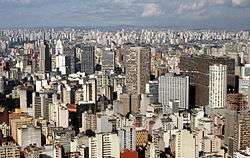
Health care and education are of major concern in the larger cities, but in smaller ones, the population are generally well-looked after.
Larger cities suffer from an increase in violence rates – mainly São Paulo and Rio de Janeiro, which suffer the effects of Drug Mafia nowadays. Unemployment rates can be as high of 22% when informal working is not considered, or as high as 11% even with informal work. This leads to misery, worsens crime rates and other social problems like begging and child labour, for example.
See also
References
- ↑ Alvares, C. A., Stape, J. L., Sentelhas, P. C., de Moraes, G., Leonardo, J., & Sparovek, G. (2013). Köppen's climate classification map for Brazil. Meteorologische Zeitschrift, 22(6), 711-728.
- ↑ "2010 IBGE Census" (PDF) (in Portuguese). IBGE.gov.br. 2010. Retrieved 3 April 2012.
- ↑ "SIDRA IBGE - Table 3175 - Resident population by color or race" (in Portuguese). 2010. Retrieved April 25, 2012.
- ↑ "January 2012 Fleet - Denatran" (zip) (in Portuguese). Denatran.gov.br. Retrieved 11 April 2012.
